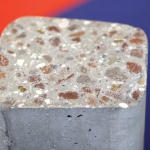In Italy, the apple orchards all look much the same—the growers collaborate to make it that way—and a common feature is concrete posts.
Manufacturers make them, growers use them, and a whole support industry has grown up to make the specialized caps, brackets, and anchors that hold wire and hail nets in place.
At the Interpoma trade show in Bolzano, Italy, in November, Good Fruit Grower interviewed Paolo Zalgelli, a representative of the 50-year-old, family-owned Italian company Valente.
The company sells concrete poles across Italy, Europe, North Africa, and Arabia, and the major disadvantage is the weight, both in shipping and handling, he said. The posts are strong and clean; there is no staining and no bleeding through of rust from re-rod.
 The posts are made, Zalgelli said, in a factory in five lines of forms, each 120 meters (almost 400 feet) long.
The posts are made, Zalgelli said, in a factory in five lines of forms, each 120 meters (almost 400 feet) long.
The secret to their strength lies in the way they are made. Lengths of high quality steel wire, at least four strands and more for larger posts, are stretched inside the form and the mix of sand, cement, and water is poured in. The concrete is vibrated to make it denser and, after it has reached a certain point in the cure, the wires are relaxed—effectively compacting the post in the long direction. The result is prestressed concrete posts.
After curing for two days, the posts are cut to length, usually five meters (just over 16 feet), and loaded for shipping.
The company is experimenting with a lighter concrete. Adding a special fiber to the mix maintains the strength, Zalgelli said, but cuts the weight by 25 percent. The 12-centimeter (5-inch) square posts weigh 25 kilograms per meter, but only 20 in the fiber version. The large end post pictured weighs about 225 pounds.
The company makes posts in four sizes—roughly 8-by-12, 7-by-7, 7-by-8, and 12-by-12 centimeters. They are not perfectly square but trapezoidal—bread-loaf shape. A centimeter is four-tenths of an inch.
One of the attractions of concrete is its extremely long life. European growers install expensive trellis and hail net support systems on land they will continually replant as new varieties arrive. So they are building permanent support structures and replacing trees, replanting them in the same rows time after time.
Walter Rass, a machinery specialist in the South Tyrol’s equivalent of the U.S. Cooperative Extension Service, said that no soil fumigation is allowed in Italy, and land is limited, so growers need to replant trees in the center alley or the same row. If they install permanent support structures, the only option is the put trees back in the same row, sometimes in the same hole.
Rass showed a video to growers traveling to Italy with the International Tree Fruit Association. He said an Italian company, Vimas, is developing a machine that, in one operation, takes soil from the old row and replaces it with soil from the center of the alley, a trade cleverly made with augers. The company has several machines for tilling and controlling vegetation. You can see them, described in German, at vimas.bz.it.
Valente was not the only company showing concrete posts at Interpoma. Another company, Spinazz, sells poles and structures. Not only are growers looking for hail protection, but cherry growers are seeking rain protection, and organic growers—and conventional as well—are looking for insect protection.
Spinazz offers what it calls a complete-cover integrated system, in which nets cover the entire orchard, including the headlands and service roads. A gate, operated by cables and pulleys, allows the net to be lifted so farming equipment can enter.
Spinazz also offers single-row covering systems. In these, there are no overhead nets. Each row of trees, on a trellis, is draped on both sides with netting that keeps out rain and insects. •
ONLINE
See the Spinazz orchard covering systems at www.spinazzegroup.com. Choose English and videos show construction, including the machines that push the tall concrete posts into the ground.








Leave A Comment